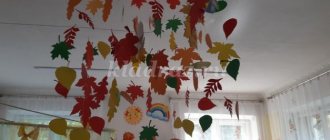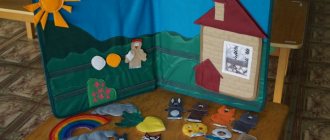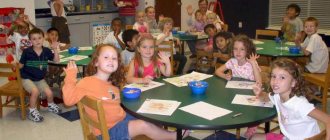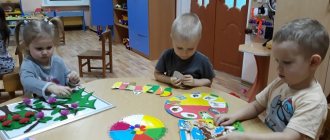Card index of theatrical games in the first junior group. card index (junior group)
Card index of theatrical games in the first junior group
Explanatory note
Theatrical play is an effective means of social-personal, cognitive-speech and artistic-aesthetic development of a preschooler. The development of theatrical play in preschoolers is more effective with a special organization of the pedagogical process.
This becomes possible if the teacher gradually reorients the child from the process of the game to its result. The path to development of play is joint play between an adult and a child, the creation of an enriched play environment that encourages independent play creativity in free interaction with toys and peers. Play as part of the educational field “Socialization” is integrated with all educational fields, since it is the main form of implementation of various types of children's activities, including organized educational activities, a method of educating and developing younger preschoolers, and a form of organizing the lives of children in kindergarten.
“The turnip grew big and big”
Russian folktale
Tasks:
Read a fairy tale to the children.
To teach listening to a story using a visual image of staged fairy tales on flannelgraph.
Game-situation “In our yard” To evoke positive emotions in children;
Enrich the experience; awaken interest in the game, the desire to imitate the intonation of an adult’s voice.
The BI-BA-BO puppet theater and flannelgraph are used
A. Barto “Toys”
Tasks:
Introduce poems.
Teach children to perform characteristic actions when reading again, repeating lines of text after the teacher
To develop the ability to convey basic emotions through facial expressions, gestures, and movements.
Encourage children's willingness to participate.
Used tabletop theater toys
Fairy tale "Kolobok"
Tasks:
Arouse interest in theatrical play through the first experience of communicating with characters.
Invite children to follow the development of the plot based on illustrations,
Develop attention and visual - effective thinking;
Learn to name characters and their actions. Reinforce in speech the names of animals and their characteristics; expand the active vocabulary: round, ruddy, red and cunning, clubfoot, etc.
Theatrical game based on a fairy tale (the theater on spoons, Bi-Ba-Bo is used;)
Nursery rhyme “Cucumber, cucumber...”
Cucumber, cucumber,
Don't go to that end
There's a mouse living there
He'll bite your tail off!
Tasks:
Teach children to pronounce a nursery rhyme. Mastering affectionate behavior (cucumber, ponytail, mouse).
Develop attention, enrich vocabulary.
Cultivate careful behavior.
Option 2. Use in a game (the mouse lives there - the children run away
Theatrical nursery rhyme game (head masks are used)
Folk game: “The gray bunny is sitting”
Tasks:
Improve the ability to examine objects, learn to examine, feel;
Learn to perform movements as shown by the teacher and pronounce the words of the song
Develop emotional responsiveness, the desire to communicate with peers, play together;
Game - the situation “The girl forgot to feed the kitten, he couldn’t remember how to ask for food.”
Tasks:
Learn to identify yourself with a theatrical character; develop mindfulness;
Learn to combine movements and speech; consolidate knowledge about the environment.
The game is the situation “For the grandfather, for the woman, the Ryaba Hen laid a golden egg.”
Tasks
Stimulate children's emotional perception of theatrical play and active participation in it;
Develop children's physical activity. Retelling a fairy tale with movements.
Strengthen the ability to imitate movements
Theatrical play based on a fairy tale, all types of theater are used
“We won’t tell you where we were, but we’ll show you what we did.”
Objectives: Encourage children's attempts to participate in a collective conversation and make joint decisions; develop creative imagination; encourage children to improvise.
Using a counting rhyme, the driver is selected. He leaves the room. Children agree on what and how they will portray. The driver returns and asks: “Where have you been, boys and girls? What did you do?" The children answer: “We won’t tell you where we were, but we’ll show you what we did.”
Children show the actions they came up with.
During the game, the teacher first advises what and how to depict. When the children get used to it, he only suggests what to depict, and how to do it, they decide for themselves
Fairy tale "Kids and the Wolf"
Tasks:
Introduce children to the work, teach them to follow the development of the plot based on illustrations. During special moments
Game "Bunnies for a walk"
Tasks:
Teach children to perform playful actions and engage in play with peers.
To develop the ability to perform basic role-playing actions. Game situation using various attributes (table theater). Circle theater, etc.)
Tasks (children hold “bi-ba-bo” dolls or ordinary toys in their hands).
1. The dolls meet each other and:
a) say hello
b) ask each other about health,
c) say goodbye.
2. One doll accidentally pushed the other. We must ask for forgiveness and, accordingly, apologize.
3. The doll is celebrating her birthday. Her friends come to her and:
a) congratulate you on your birthday and give gifts.
b) the doll thanks for the congratulations and invites you to the table.
c) one of the guests was late: ask for forgiveness for being late.
d) one of the guests accidentally spilled compote on the tablecloth, play out the actions of the hosts and the offender.
3. Some tasks can be offered to children to complete without dolls:
a) knock, go into the group and call one of the children with a gesture (silently, so as not to interrupt the teacher’s story);
b) go to the head (methodologist, speech therapist, etc.) and give her a message;
c) explain to “mom” why clothes are dirty after visiting kindergarten;
d) apologize to the children for the fact that the ball rolled and broke the sand buildings.
“Theatrical activities as a means of communicative development of young children”
-creating interest in theatrical games, constantly expanding the gaming experience, encouraging and developing children’s aspirations for theatrical and gaming activities;
- interaction between children and adults.
In the corner of theatrical activities in our group, we tried to collect different types of theaters: tabletop, finger, theater on the hand, on flannelgraph, sets of dolls, costume elements, masks, pencils, paints, glue, paper, attributes. Corner materials are constantly changing.
Forms of organizing theatrical activities
Theatrical games are used in different types of activities:
• In special moments
• During organized educational activities
(as a surprise moment)
• In free joint activities of children and adults
(Playing out nursery rhymes, fairy tales, games)
During special moments, for example, in the education of cultural and hygienic skills, the character - the doll Katya shows how to properly wash your hands and use a towel; while eating, a girl Masha from a fairy tale comes to visit them and shows them how to hold a spoon correctly and use a napkin; The cat-Purr sings lullabies before going to bed.
During organized educational activities, we use dolls - characters in surprise moments, to create motivation and maintain interest in the process of educational activities; for organizing plot-displaying, outdoor games.
However, children at this age cannot develop and play out the entire plot, since they do not have enough experience in game actions. To expand the gaming experience, we use individual work with children, introduce children to various types of theater, and also perform small performances.
Our theater corner contains various types of theaters and puppets, theatrical masks, which are the most effective, understandable and accessible for our kids. Also in the corner there is a screen that allows you to make the puppet show more interesting, a tape recorder with recordings of music for performing sketches and mini performances, children’s favorite books, baby books, and toy books. So, let's take a closer look at each type of theater.
Tabletop: rubber toy theater, cube theater, wooden. The table theater helps to teach how to coordinate hand and eye movements and accompany finger movements with speech. Express your emotions through facial expressions and speech. It is simple and accessible, does not require certain skills, children themselves act with toys - characters, willingly transform into acting characters (Bug Dog, cat, mouse, etc., try to convey the character of the hero (with facial expressions, changing intonation, repeating remembered phrases. We use the tabletop theater to get acquainted with literary works and fairy tales (“Masha and the Bear” by M. Bulatov, “Teremok” by M. Bulatov, “The Little Goats and the Wolf” by K. Ushinsky, folk tales “Kolobok”, “ Chicken Ryaba"); at the same time, we introduce children to gestures, facial expressions (feign surprise, show an angry wolf, a cheerful bunny, with movements (for example: threaten, stomp, clap, scare). With characters from fairy tales we listen and sing, dance and play, get acquainted with musical instruments.




